- Vata body type
- Imbalance symptoms
- How to balance Vata
- Vata dosha diet
- Ayurvedic herbs
- Oil massage
- Yoga and meditation
- Essential oils
- Warm yourself
- Lifestyle tips

According to Ayurveda, Tridoshas – Vata, Pitta, and Kapha – are the fundamental principles and bioenergy forces of nature that enable us to comprehend ourselves and the rest of the world.
Vata dosha is the energy associated with air and space element therefore it predominates motion, impulsivity, and creation in the body and mind. The air and space element combinedly makes the qualities of Vata dosha; It’s subtle, cold, light, sharp, rough, brittle, bright, mobile, dry, etc. and hence, associated with the fall and winter seasons.
When Vata is in balance, we feel alert and lively. We sleep well and digest food easily. However, when Vata is out of balance, we can experience imbalance Vata symptoms like dryness, joint pain, bloating, constipation, weight loss, arms & legs veins dilation, pulsation, and feeling of emptiness etc.
In this article, we will discuss how you can balance the Vata dosha through different foods, ayurvedic herbs, and simple lifestyle changes.
What does a Vata body look like?

People with Vata dosha have thin small bodies and may be extremely tall or short. They’ll walk quickly yet unsteadily. Their skin is dull and dry and has occasional greasy spots. Small, dry hair, thin eyebrows, and a slender face with small eyes characterize them.
They are prone to tanning and have chilly hands and feet. They will experience erratic sleep patterns and frequent nighttime awakenings. Then they will feel exhausted out of the blue after having energy spurts.
They lack the capacity to store energy and put on weight as a result of their irregular cravings and weak digestion.
People that are Vata tend to be irritable and have limited attention spans. But they are also excellent learners, highly spirited, adaptable, and prefer to take the initiative. They are also very engaging. inventive, creative, and imaginative.
Symptoms of Vata Dosha Imbalance
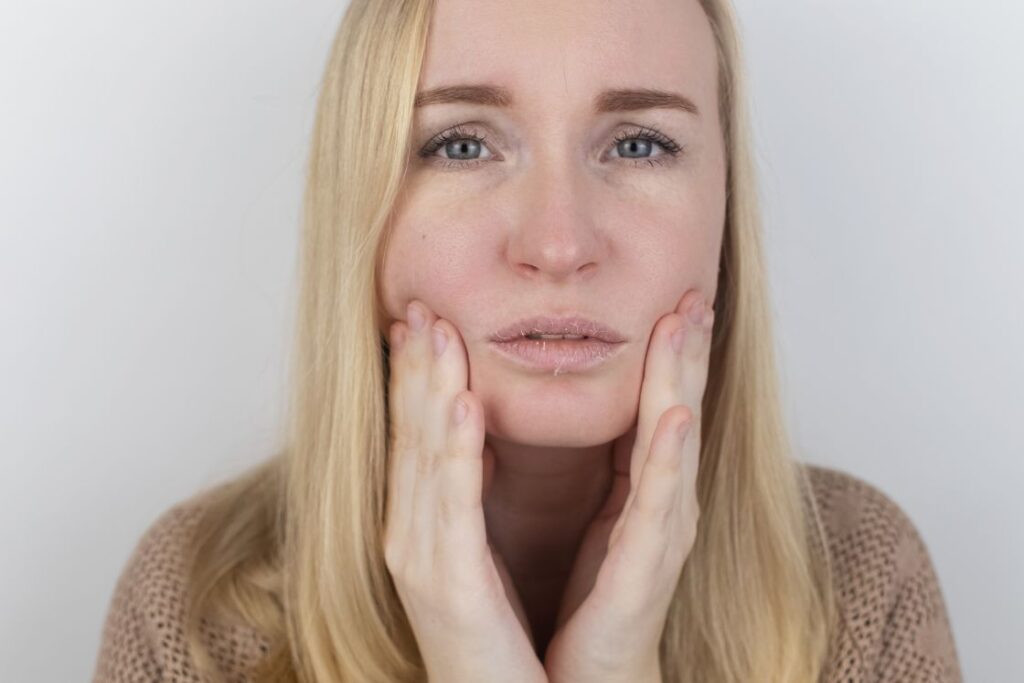
The primary symptoms of an unbalanced Vata dosha are:
- Dryness – This can manifest as dry skin, dry eyes, or a feeling of overall body dryness.
- Coldness – Vata individuals may feel cold more easily than others and may also experience body aches and pains in cold weather.
- Roughness – Unbalanced Vata can cause the skin to become rough and cracked, the hair to become brittle and dry, and the nails to become weak and chipped.
- Fearfulness – Those with an imbalance in Vata dosha are hyperactive physically and mentally, therefore, may tend to worry excessively or be prone to fearfulness and anxiety.
- Restlessness – An individual with an imbalanced Vata may have difficulty sleeping or relaxing, feeling instead wired or jumpy.
Some other symptoms are:
- Excessive bloating or gas due to a disturbed Apana Vayu.
- Constipation due to aggravated air element that dries up the feces.
- Excessive weight loss
- Restlessness, dizziness, feeling ungrounded
- Headache, fatigue, loss of strength
- Insomnia, light sleep
- Poor blood circulation
- Asthma, pain and aches,
- Fidgeting, agitation, muscle twitching, palpitations, muscle spasm
- Joint pain and muscle stiffness or cramps
- Difficulty tolerating loud noises
- Spacey, scattered feeling, confused
- Excess thinking or worrying
If you are experiencing any of these symptoms, it’s important to take steps to balance your vata.
How to Balance Vata Dosha?
Balancing Vata dosha involves targeting its qualities and making changes accordingly. You need to cater to the qualities of Vata being subtle, cold, light, sharp, hard, rough, subtle, brittle, bright, mobile, and dry to make a regime that you can follow.
A Vata balancing routine includes eating warm, grounding and home-cooked food in a timely manner; avoid dry, processed or uncooked foods, especially salads and raw fruits and vegetables (because more fiber in them makes them rough). Add some structure to your lifestyle; include light but a regular exercise in your daily routine and sit quietly for five minutes after eating. It will remove excess Vata from the body.
There are many ways to bring Vata dosha back into balance including appropriate diet, massage, herbs, lifestyle tips, etc. Let us have a look at each of them in detail.
1. Consume warm and cooked foods
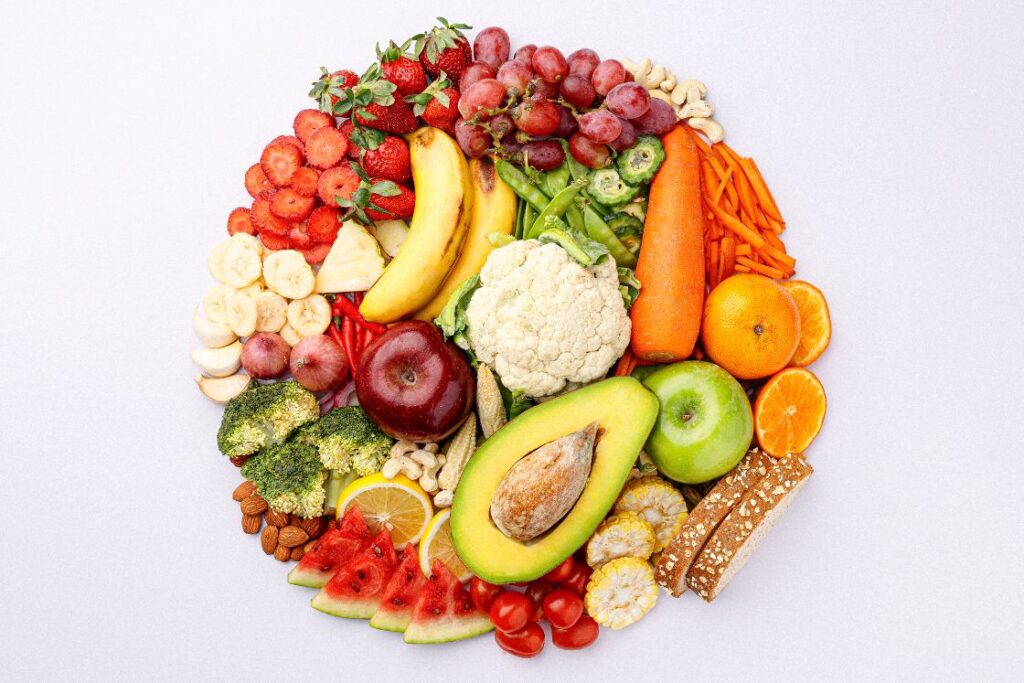
The Vata-pacifying diet emphasizes foods that are warm, cooked and sweet in taste. Vata requires warm, mushy foods for better digestion to counteract its quality of being cold, rough, and dry.
Vata will increase if you eat a lot of raw, cold, and dry meals, which will make you feel bloated, gassy, and constipated. During the autumn and winter, this becomes essential to remember.
According to Ayurveda, vata people should prefer sweet, sour, and salty flavours foods and avoid foods which are bitter, pungent, and astringent in taste. Also avoid raw fruits, vegetables, frozen foods, leftovers, cold and fizzy beverages to keep Vata in balance. Be sure to hydrate yourself with plenty of water as well.
A Vata dosha diet includes foods;
- Fruits: Take very ripe, juicy and sweet taste fruits for balancing Vata dosha. It includes papaya, mangoes, peaches, apples, pears, apricots, cherries, coconut, and avocados.
- Vegetables: Vata-pacifying vegetables include root vegetables like potatoes, carrots, sweet potatoes, and winter squash, as well as other grains and legumes such as spelt, quinoa, mung beans, adzuki beans, chickpeas and corn.
- Spices: Cumin, turmeric, coriander, ginger, asafoetida (hing), black pepper, cinnamon and fennel.
- Oils: Use ghee, avocado, coconut, and sesame oil for cooking.
2. Use Ayurvedic herbs to calm an agitated Vata
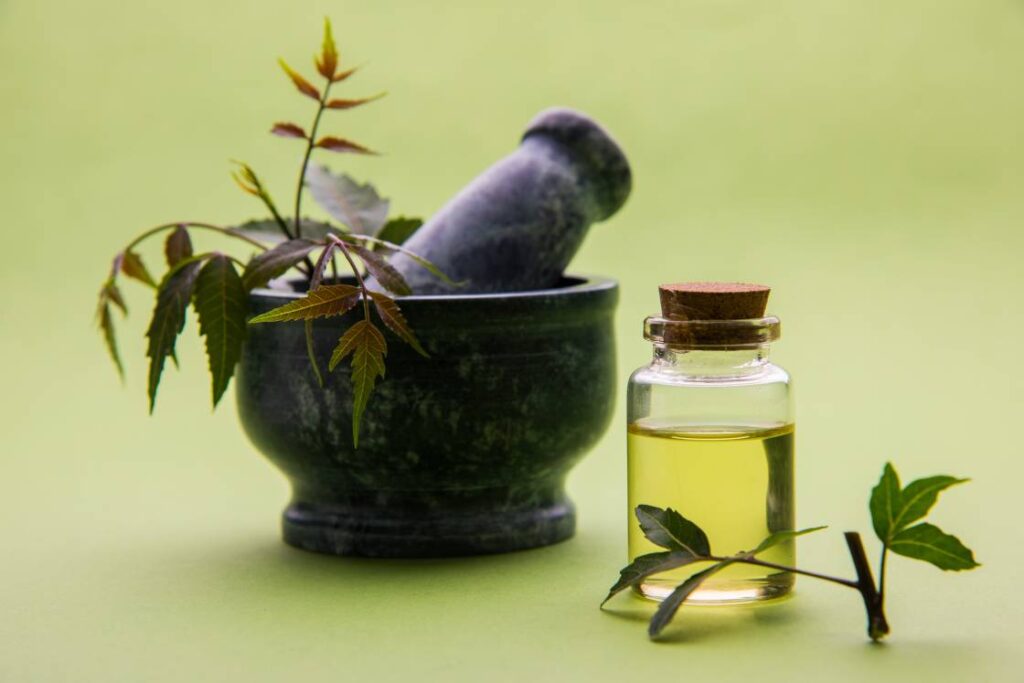
For an unbalanced Vata, you should use Ayurvedic herbs which have warm, nourishing, and grounding properties. They can provide a great deal of relief for those suffering from Vata-related ailments such as chronic fatigue, irritability, and digestive issues.
To properly utilize ayurvedic herbs for restoring balance to overwhelmed Vata levels, it is important to consider the climate and season when crafting a herbal regimen. During cold winter months or when feeling stressed, herbs like saffron, ginger root, Shatavari root, Amalaki berry, and Gotu kola can be helpful.
Utilizing adaptogenic herbs like ashwagandha and Rhodiola during periods of emotional imbalance or restlessness can help calm the nerves. While the use of cooling spices like cardamom in teas or powder form can help regulate emotional fluctuations typically associated with Vata imbalances.
3. Regularly oiling your body through massages

Oils are a crucial component of many Vata-reducing regimens because Vata is dry by nature. Massaging with oil provides nourishment and hydration to the body, while simultaneously helping to reduce thinning of the skin.
Vata people should give themselves a morning oil massage before taking a shower to treat dry skin, increase circulation, and improve joint health.
Popular oil choices for balancing Vata include sesame oil, almond oil, sunflower and olive oil, as well as other warm and thicker Ayurvedic massage oils such as Brahmi oil. Bhringraj is one of the most preferred oils for a head massage as it removes dryness and cools your head during times of stress. It can help in reducing stress-related hair fall or breakage.
Best practices for using vata balancing oils involve applying them in circular motions on moist skin or adding a few drops of essential oil before steaming your body. One way these oils can be used is through Abhyanga massage—which involves massaging them into the skin in a gentle but firm circular motion towards the heart using long strokes. Shirodhara is yet another excellent method of topical oiling.
4. Ground yourself with yoga and meditation
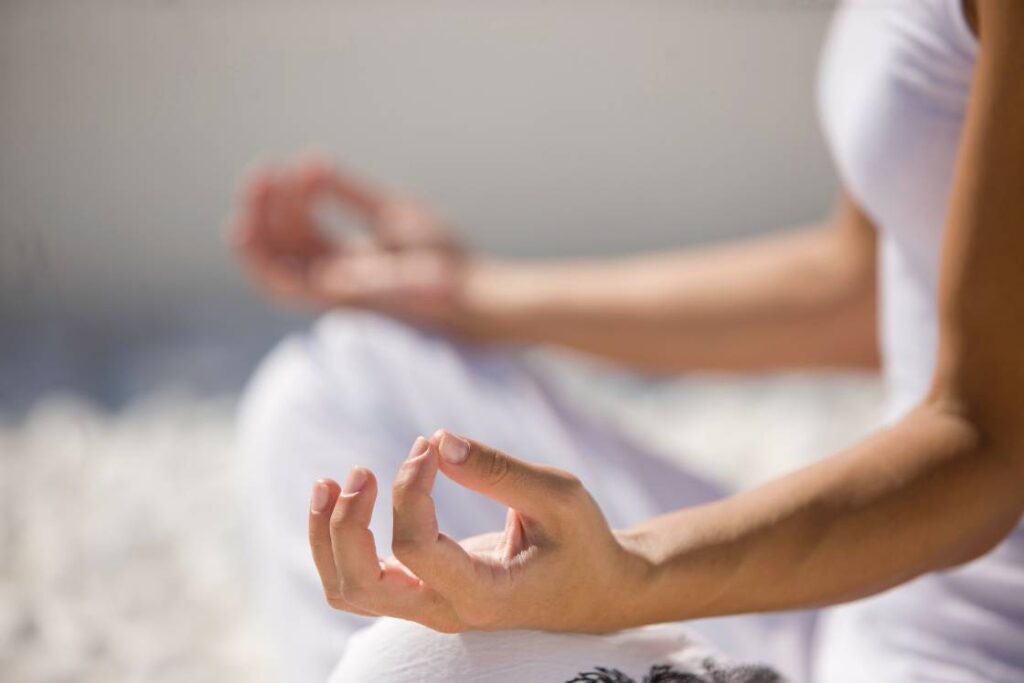
Gentle yoga that provides firmness or restorative is an effective practice for lowering Vata. Vata requires calm, steady, grounded motions, and this kind of yoga will slow down the dynamic energy.
Vata person should hold each yoga posture for a short amount of time but do multiple repetitions. It is important to practice moderately and slowly. Learn more about yoga to balance Vata dosha.
A grounding sequence for balancing vata dosha can include the following poses.
- Chair Pose (Utkatasana)
- High Lunge
- Child’s Pose (Balasana)
- Wide-Legged Standing Forward Bend (Prasarita Padottanasana)
- Standing Forward Bend (Uttanasana)
- Garland Pose (Malasana)
- Locust Pose (Salabhasana)
- Thunderbolt Pose (Vajrasana)
- Legs up the Wall Pose (Viparita Karani)
- Cat-Cow Stretch
These vata yoga asanas aid in the relief of vata-related problems like headaches, arthritic pain, sleeplessness, and other digestive issues like constipation, bloating, etc.
Also read: Yoga mudras for balancing vata dosha
Meditation
Since vata people have a short attention span and get restless easily, meditation that involves focusing on an object will be beneficial. Vata people should try out mantra meditation, and open-eye meditation techniques such as trataka, or focus your awareness on calming sounds such as ocean waves, chirping of birds, chimes, etc.
Mindfulness meditation techniques such as walking on grass or coloring a mandala can further help bring quiet and peace to Vata people’s mind. Being with nature is an excellent way to connect with Mother Earth to gain its grounding energy. Transcendental Meditation, Zen Meditation, and Yoga Nidra are also preferable.
Pranayama
You can also take up pranayama practice along with asanas and meditation to keep the air element of Vata dosha in balance. The Prana and Udana Vayu are the main types of Vata through which oxygen gets circulated in the body. To keep the Udana Vayu in balance, practising Ujjayi Pranayama will be fruitful to improve your speech, memory, and immunity.
Nadi Shodhana, Anulom-Vilom, and Bhramari Pranayama are all-rounders that can cure almost all issues caused by the imbalance of Vata dosha. These will improve mental clarity, promote calmness, enhance the quality of sleep, alleviate headaches, and stimulates the nervous system.
5. Apply Vata pacifying essential oils to calm your mind
When choosing essential oils for Vata dosha, opt for earthy or grounding, warming, relaxing, and pleasant scents. Some of the recommended essential oils are cinnamon, fennel seed, ginger, orange, citrus, lemongrass, lavender, sandalwood, ylang-ylang, frankincense, jasmine, and vanilla.
For relaxing Vata, lavender works wonders. It is well known for encouraging deep sleep while also having relaxing effects on the mind. It also has the power to uplift emotions. Lavender can be applied directly to the skin and is excellent for direct palm inhalation.
Traditionally, any essential oil is mixed with a base or carrier oil to enhance its effect. For vata doshas, sesame, jojoba, or almond oil is often used due to its earthy and grounding aroma.
Since most vata pacifying essential oils are safe to use on the skin, you can apply a few drops on your wrist or mix it in your bath water and massage oils. Many people also put a few drops of their favorite essential oil, especially lavender, on their pillows to promote good sleep.
Applying sesame oil infused with Vata-reducing essential oils to the feet before the night is one of the most effective practices. Another common method is through a diffuser which will spread the droplets of essential oil in the air.
Also read: Essential oils for chakra balancing
6. Keep yourself warm and cozy when going outside
Winter and fall seasons are said to be the peak time for Vata. So it doesn’t go without saying that this is the time when you should be extremely careful about Vata going out of balance.
To keep Vata in balance during winter, layer yourself with a hat, scarf, jacket, coat, and gloves whenever you go out. Put on outfits consisting of supple yet warm fibers in earthy or gentle pastel hues to soothe Vata. It is also essential to cover the head, ears, and throat if it is chilly or windy outside.
Since vata is a cold and dry dosha, it’s crucial to ensure that your home and place of work are adequately heated and have a suitable humidity level. It is advisable to stay away from drafts and to sit far from fans or ventilators because Vata is highly sensitive to air movement.
7. Incorporate the Vata lifestyle into your daily routine
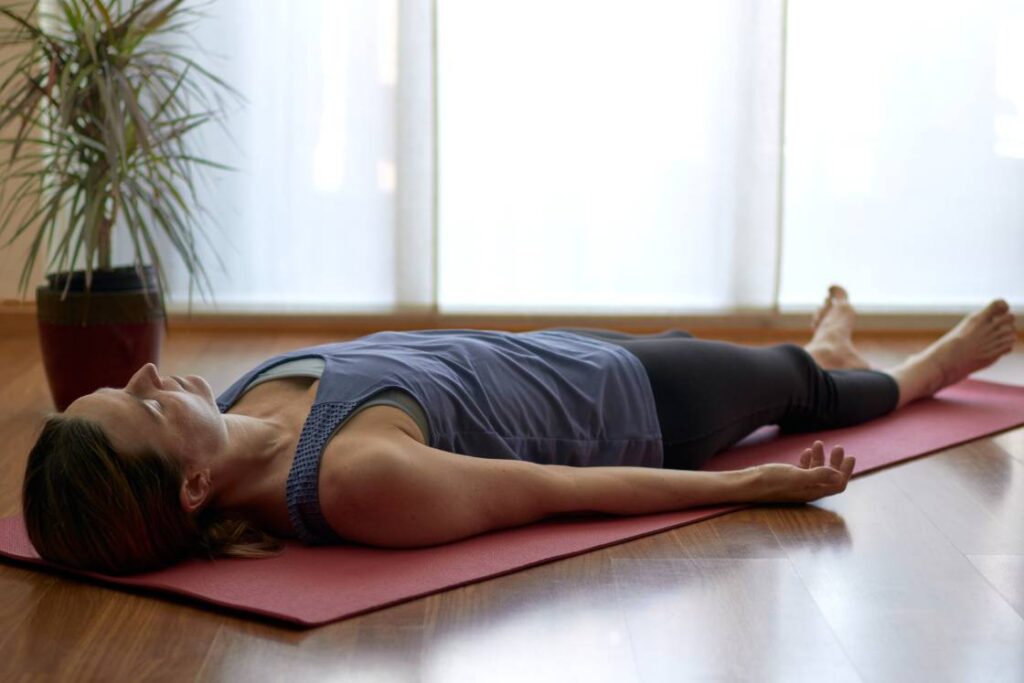
The following lifestyle tips can all be helpful in keeping Vata dosha in balance:
- Create a simple daily routine and try to stick to it. Go to bed at a consistent time (preferably around 10 pm), wake up early, and then do some warm-up yoga exercises.
- Incorporate oil massage and drink teas or warm beverages in your morning routine.
- Don’t skip your meals. Always eat at the same time and at regular intervals throughout the day.
- Eat mindfully and slowly in a peaceful environment. Rushing through eating will ultimately lead to digestive disorders and will further aggravate the Vata imbalance.
- To quiet your hyperactive mind, consider lying in Savasana for a few minutes each day or going on a silent walk.
Conclusion
Keeping your vata in balance will help you in keeping the other doshas in check as well. Following the above tips should always be preceded by a consultation with an expert ayurvedic practitioner to diagnose the correct dosha symptom.





